GNSS-R Altimetry Performance Analysis for the GEROS Experiment on Board the International Space Station
Abstract
:1. Introduction
1.1. The Mission
- To measure and map altimetric sea surface height of the ocean with an accuracy of 30 cm or better (goal: 20 cm) using reflected GNSS signals to allow methodology demonstration, establishment of error budget and resolutions and comparison/synergy with results of satellite based nadir-pointing altimeters. This includes Precise Orbit Determination of the GEROS payload.
- To retrieve scalar ocean surface mean square slope (MSS), which is related to sea roughness, wind speed, with a GNSS spaceborne receiver to allow methodology testing, establishment of error budget and resolutions. MSS accuracy should be equivalent to a wind accuracy of 10% or 2 m/s whichever is greater. In addition, 2D MSS (directional MSS, related to wind direction) would be desirable.
- To assess the potential of GNSS scatterometry for land applications and in particular to develop products such as soil moisture, vegetation biomass, and mid-latitudes snow/ice properties and to further explore the potential of GNSS radio occultation data (vertical profiles of atmospheric bending angle, refractivity, temperature, pressure, humidity and electron density), particularly in the Tropics, to detect changes in atmospheric temperature and climate relevant parameters (e.g., tropopause height) and to provide additional information for the analysis of the reflectometry data from GEROS” (from [2]).
1.2. GEROS-ISS: The Payload
2. Methodology: Computation of the Altimetry Performance
2.1. Basic Instrument Performance
2.2. Non-Instrumental Error Sources in GNSS-R Altimetry
2.2.1. Electromagnetic Bias
2.2.2. Impact of the Ionosphere
2.3. Instrumental Error Sources in GNSS-R Altimetry
- Maximum and minimum ISS orbital heights considered to compute the maximum off-boresight angle for a given swath of 500 km (i.e., 250 km half swath in each side, nominal off-boresight angle = 35°).
- Antenna: instead of the hexagonal 19 element antenna array (Figure 5a) foreseen for PARIS IoD [6], a rectangular 31 element antenna array (Figure 5b) was selected for GEROS-ISS, since larger apertures fit in the available space in the upper deck of the Columbus module. This translates into an increased directivity and increased signal-to-noise ratio. The array topology and the numerically computed elementary antenna patterns have been used to estimate the directivities for the up and down-looking antennas, at boresight and at 35° or the corresponding angle to the maximum off-boresight angle for each orbital height, and swath, and for the lower (L5/E5) and upper (L1/E1) bands. Array parameters are summarized in Table 3.
- Receivers noise figure is NFnom = 3.5 dB.
- Receivers bandwidth is B = 40 MHz.
- Dwell line is 100 km, unless otherwise specified. Results for a 1 ms coherent integration, and 1 s integration (incoherent averaging) time are also provided.
- All other instrumental error sources, etc. as in [6].
- Inter-modulation signal power is taken into account. The inter-Modulation (IM) components are extra signal components transmitted by the GPS navigation satellites to keep the power envelope of the composite signals constant, so as to improve the performance of the solid state power amplifiers (SSPAs). The IM signals do not transmit navigation information, so they have no impact in conventional GNSS-R (cGNSS-R) or reconstructed-code GNSS-R (rGNSS-R) [13], but they do in the interferometric GNSS-R (iGNSS-R), because this later technique cross-correlates the whole signal. The IM signal accounts for a 25% of the total transmitted power, so the SNR is increased by 4/3 (1.25 dB). Figure 6a,b show the power spectral density (PSD), and the squared auto-correlation function (ACF) of the composite GPS L1 signal with (red) and without (blue) considering the IM component. As it can be appreciated, not only the power is higher, but it is more concentrated towards the higher frequencies, which increases the Gabor bandwidth (Equation (5)), and the achievable altimetry precision.
2.4. Platform Error Sources in GNSS-R Altimetry
2.4.1. Impact of ISS Orbital Height Decay
2.4.2. Impact of ISS Shadowing and Multiple Scattering
3. Results: Predicted GNSS-R Altimetry Performance
3.1. GNSS-R Altimetry Performance and Trade-off between Techniques
3.2. GNSS-R Altimetry Performance Sensitivity to Errors
4. Discussion
- (1)
- the use of the Cramer-Rao bound has been used to assess the performance of an ideal instrument performance, including now more directive antennas,
- (2)
- ionospheric effects,
- (3)
- the ISS orbit height decay rate, and
- (4)
- multi-path propagation due to reflections in the ISS structure, including diffraction in curved surfaces. It has been shown that there are up to 3rd order rays (2 reflections), with delays spanning up to ~150 ns and ~300 ns for the 2nd and 3rd order rays. These coherent reflections can be mitigated as suggested in [18], but it will have an impact of the scatterometry observables over land and the cryosphere.
5. Conclusions
Acknowledgments
Author Contributions
Conflicts of Interest
References and Notes
- Wickert, J.; Cardellach, E.; Martin-Neira, M.; Bandeiras, J.; Bertino, L.; Andersen, O.B.; Camps, A.; Catarino, N.; Chapron, B.; Fabra, F.; et al. GEROS-ISS: GNSS REflectometry, Radio Occultation, and Scatterometry Onboard the International Space Station. IEEE J. Sel. Top. Appl. Earth Obs. Remote Sens. 2016, 9, 4552–4581. [Google Scholar] [CrossRef]
- GNSS Reflectometry, Radio Occultation and Scatterometry onboard ISS (GEROS-ISS)—SYSTEM REQUIREMENTS DOCUMENT, GEROS ESA Team, Ref. TEC-ETP/2013.202/MMN, Issue 1.1, rev. 0, date: 22/01/2014.
- Kay, S.M. Fundamentals of Statistical Signal Processing: Estimation Theory; Prentice Hall: Upper Saddle River, NJ, USA, 1993. [Google Scholar]
- Camps, A.; Martin, F.; Park, H.; Valencia, E.; Rius, A.; D’Addio, S. Interferometric GNSS-R achievable altimetric performance and compression/denoising using the wavelet transform: An experimental study. In Proceedings of the 2012 IEEE International Geoscience and Remote Sensing Symposium (IGARSS 2012), Munich, Germany, 22–27 July 2012; pp. 7512–7515. [Google Scholar]
- Camps, A.; Pascual, D.; Park, H.; Martin, F. PARIS IOD: ID-16A Contribution to Performance and Error Budgets Report, PARIS-PhA-IEEC-UPC-TN-008, v3.0, 14/11/2012.
- Camps, A.; Park, H.; Valencia i Domenech, E.; Pascual, D.; Martin, F.; Rius, A.; Ribo, S.; Benito, J.; Andres-Beivide, A.; Saameno, P.; et al. Optimization and Performance Analysis of Interferometric GNSS-R Altimeters: Application to the PARIS IoD Mission. IEEE J. Sel. Top. Appl. Earth Obs. Remote Sens. 2014, 7, 1436–1451. [Google Scholar] [CrossRef]
- Tress, H.L.V. Detection, Estimation and Modulation Theory, Part III: Radar-Sonar, Signal Processing and Gaussian Signals in Noise; Wiley: New York, NY, USA, 1971; Chapter 10. [Google Scholar]
- Pascual, D.; Camps, A.; Martin, F.; Park, H.; Arroyo, A.A.; Onrubia, R. Precision Bounds in GNSS-R Ocean Altimetry. IEEE J. Sel. Top. Appl. Earth Obs. Remote Sens. 2014, 7, 1416–1423. [Google Scholar] [CrossRef]
- Martin-Neira, M.; D’Addio, S.; Buck, C.; Floury, N.; Prieto-Cerdeira, R. The PARIS Ocean altimeter. IEEE Trans. Geosci. Remote. Sens. 2011, 49, 2209–2237. [Google Scholar] [CrossRef]
- Elfouhaily, T.; Thompson, D.; Vandemark, D.; Chapron, B. Weakly nonlinear theory and sea state bias estimations. J. Geophys. Res. 1999, 104, 7641–7647. [Google Scholar] [CrossRef]
- Ghavidel, A.; Schiavulli, D.; Camps, A. Numerical Computation of the Electromagnetic Bias in GNSS-R Altimetry. IEEE Trans. Geosci. Remote. Sens. 2016, 54, 489–498. [Google Scholar] [CrossRef]
- P.531: Ionospheric Propagation Data and Prediction Methods Required for the Design of Satellite Services and Systems. Available online: https://www.itu.int/rec/R-REC-P.531/en (accessed on 4 July 2017).
- Zavorotny, V.U.; Gleason, S.; Cardellach, E.; Camps, A. Tutorial on Remote Sensing Using GNSS Bistatic Radar of Opportunity. IEEE Geosci. Remote Sens. Mag. 2014, 2, 8–45. [Google Scholar] [CrossRef]
- Li, W.; Rius, A.; Fabra, F.; Martín-Neira, M.; Cardellach, E.; Ribó, S.; Yang, D. The Impact of Inter-Modulation Components on Interferometric GNSS-Reflectometry. Remote Sens. 2016, 8, 1013. [Google Scholar] [CrossRef]
- Park, H.; Pascual, D.; Camps, A.; Martin, F.; Alonso-Arroyo, A.; Carreno-Luengo, H. Analysis of Spaceborne GNSS-R Delay-Doppler Tracking. IEEE J. Sel. Top. Appl. Earth Obs. Remote Sens. 2014, 7, 1481–1492. [Google Scholar] [CrossRef]
- ISS (High Res). Available online: https://nasa3d.arc.nasa.gov/detail/iss-hi-res (accessed on 5 July 2017).
- newFASANT: Simulation Software for Electromagnetic Field Analysis. Available online: https://www.fasant.com/en (accessed on 10 May 2017).
- Martin, F.; Camps, A.; Fabra, F.; Rius, A.; Martin-Neira, M.; d’Addio, S.; Alonso, A. Mitigation of Direct Signal Cross-Talk and Study of the Coherent Component in GNSS-R. IEEE Geosci. Remote Sens. Lett. 2015, 12, 279–283. [Google Scholar] [CrossRef]
- Navstar GPS Space Segment/Navigation User Interfaces. Available online: www.gps.gov/technical/icwg/IS-GPS-200G.pdf (accessed on 5 July 2017).
- Galileo Open Service SIS ICD: New Version 1.2. Available online: https://www.gsc-europa.eu/system/files/galileo_documents/Galileo-OS-SIS-ICD.pdf (accessed on 5 July 2017).
- Onrubia, R.; Querol, J.; Pascual, D.; Park, H.; Alonso-Arroyo, A.; Camps, A. Assessment of DME/TACAN RFI mitigation techniques in GNSS-R. In Proceedings of the 2016 IEEE International Geoscience and Remote Sensing Symposium (IGARSS), Beijing, China, 10–15 July 2016; pp. 4811–4814. [Google Scholar]
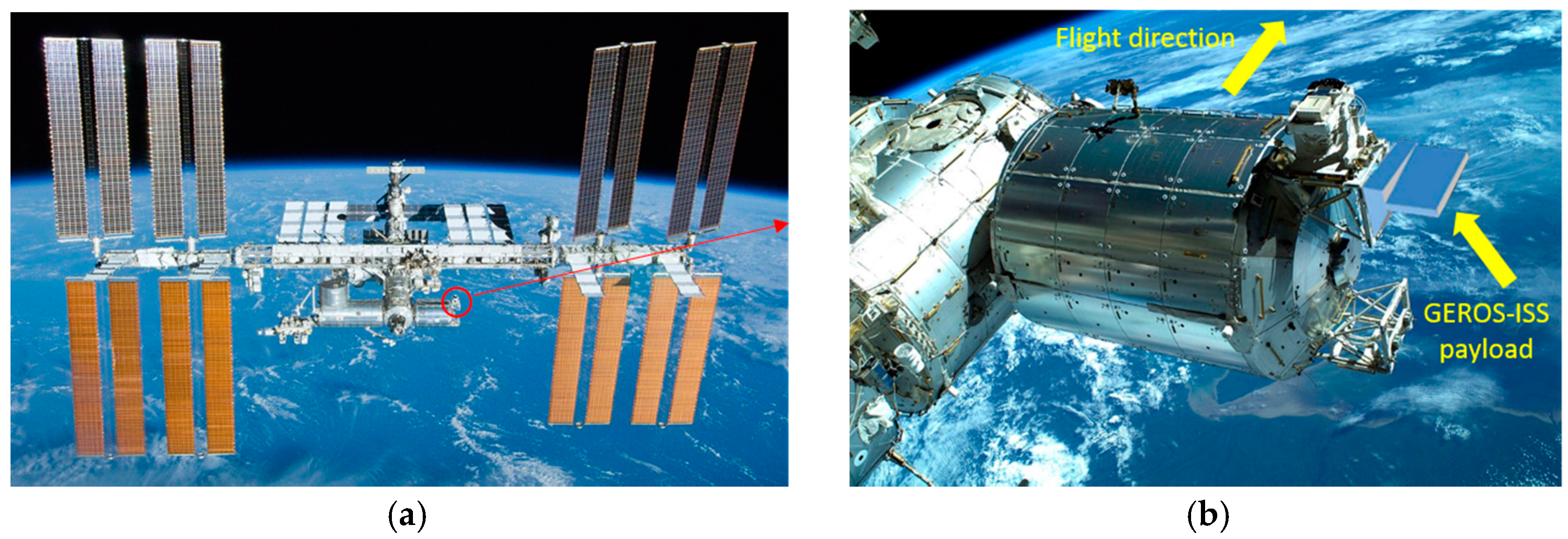
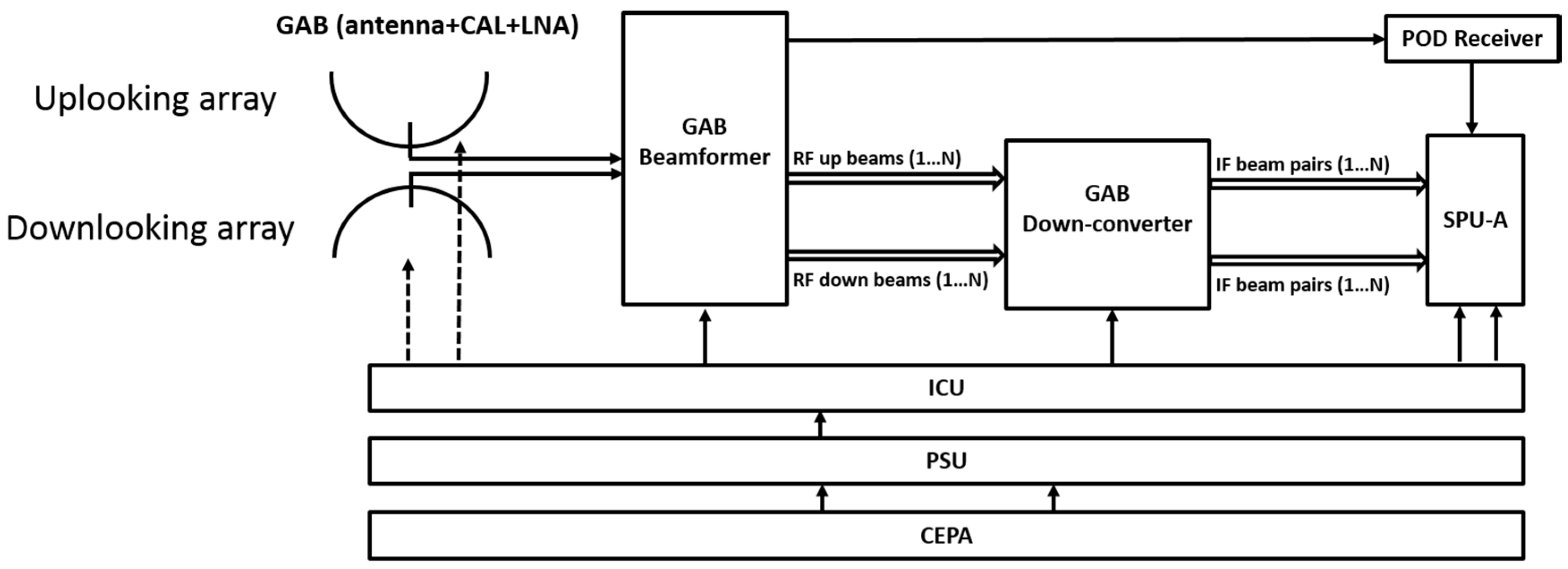


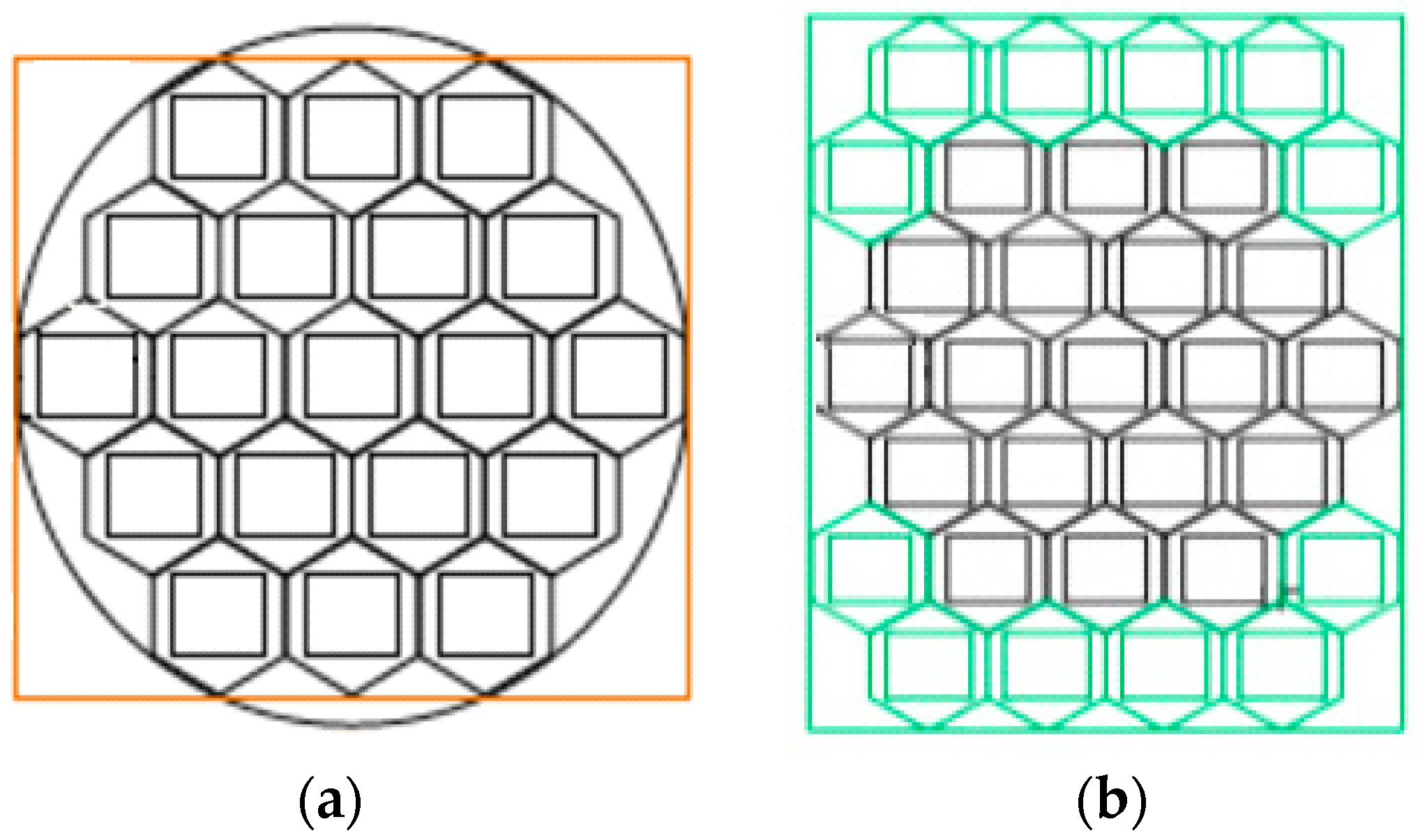
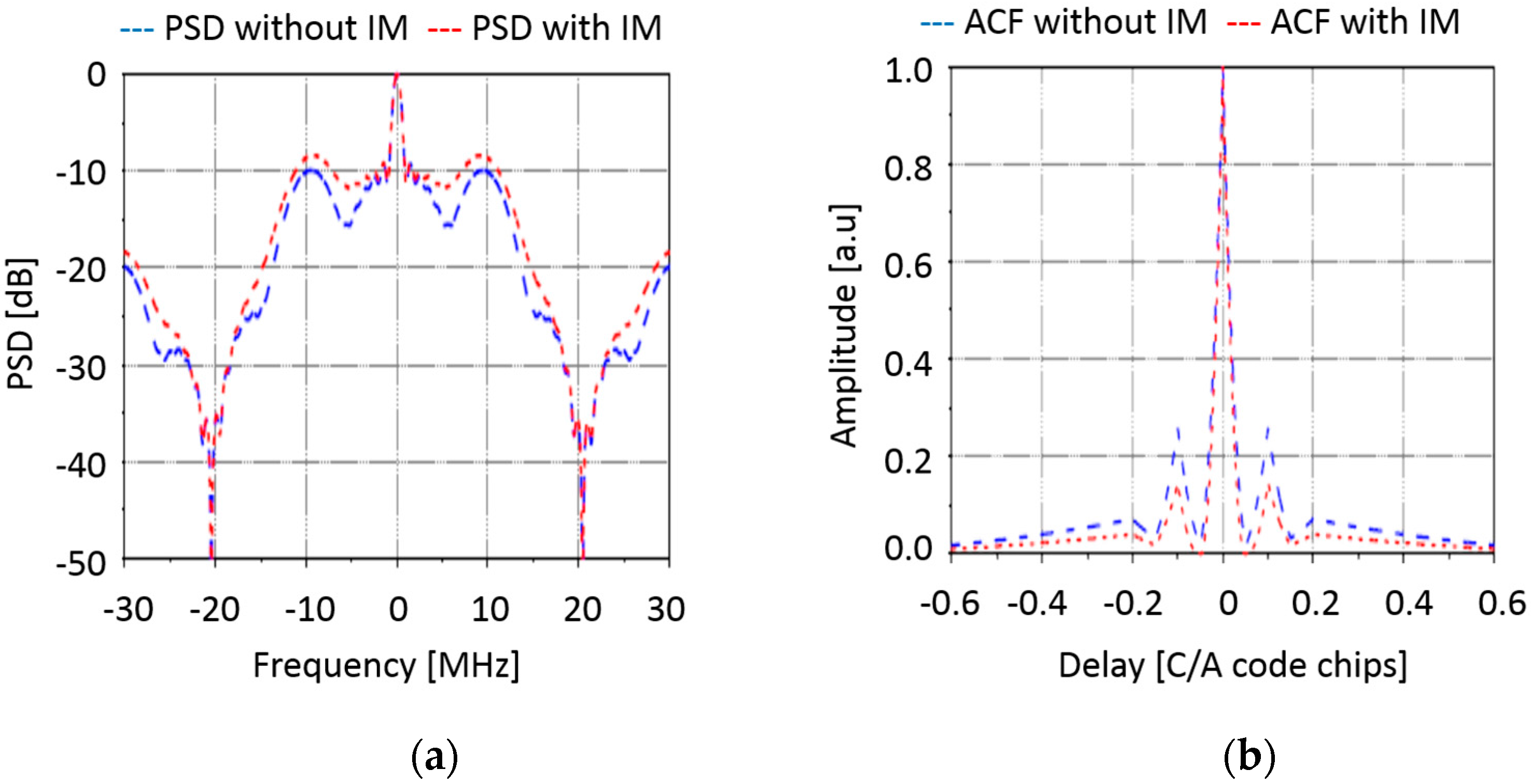
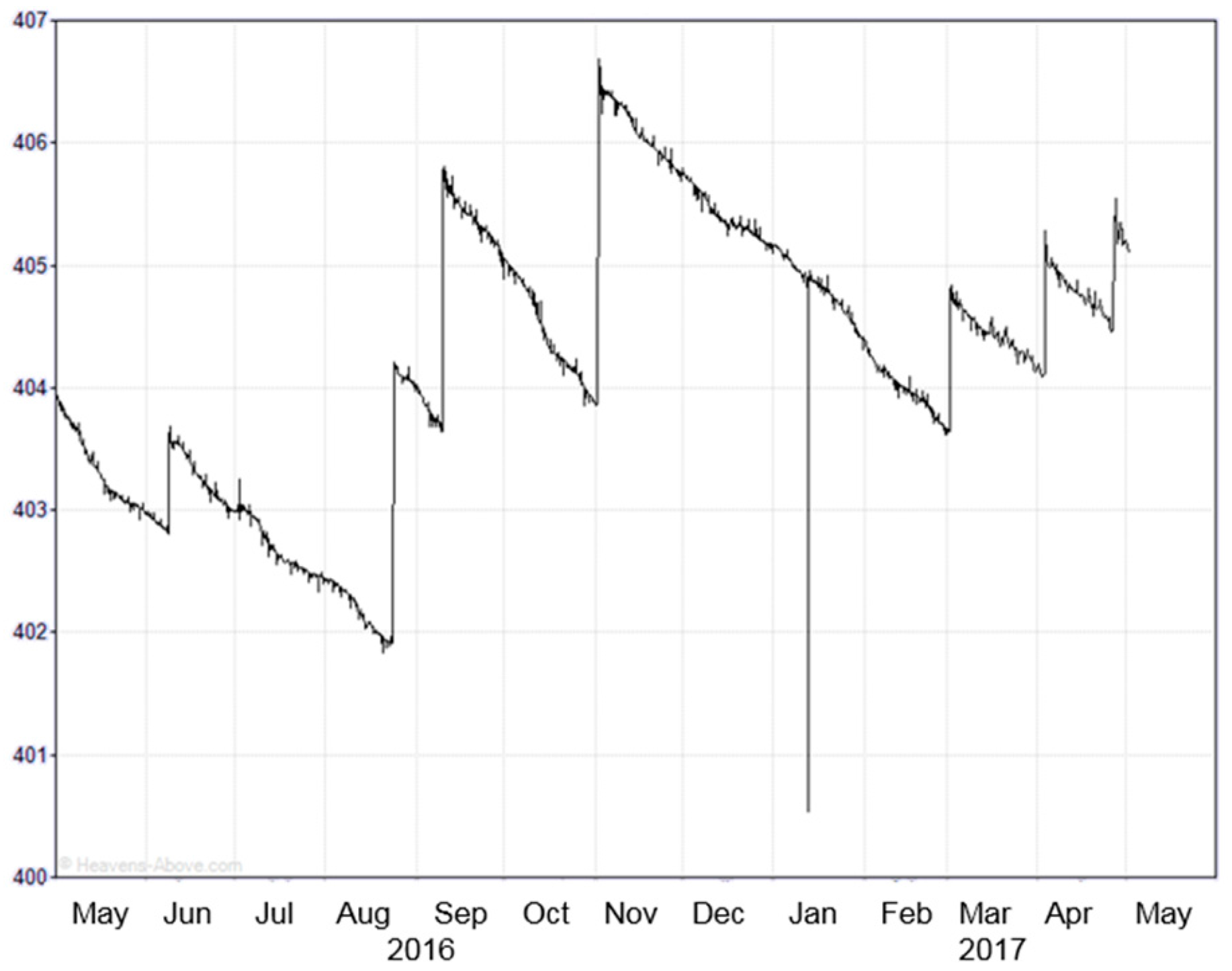
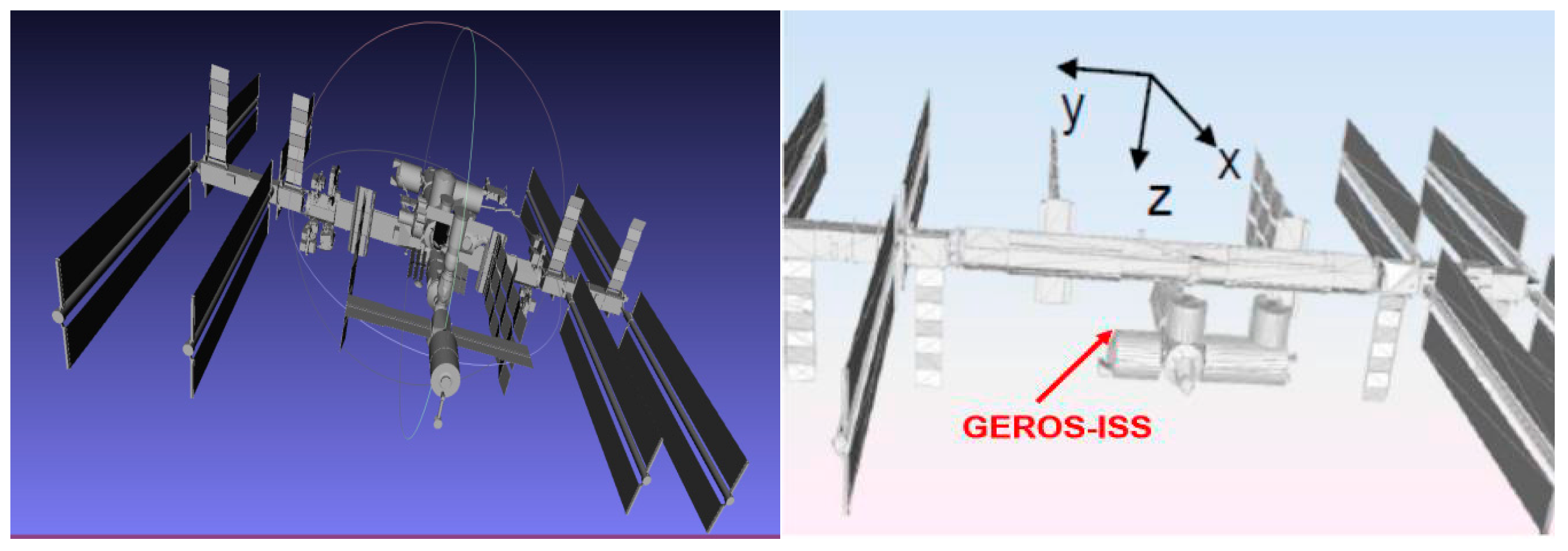
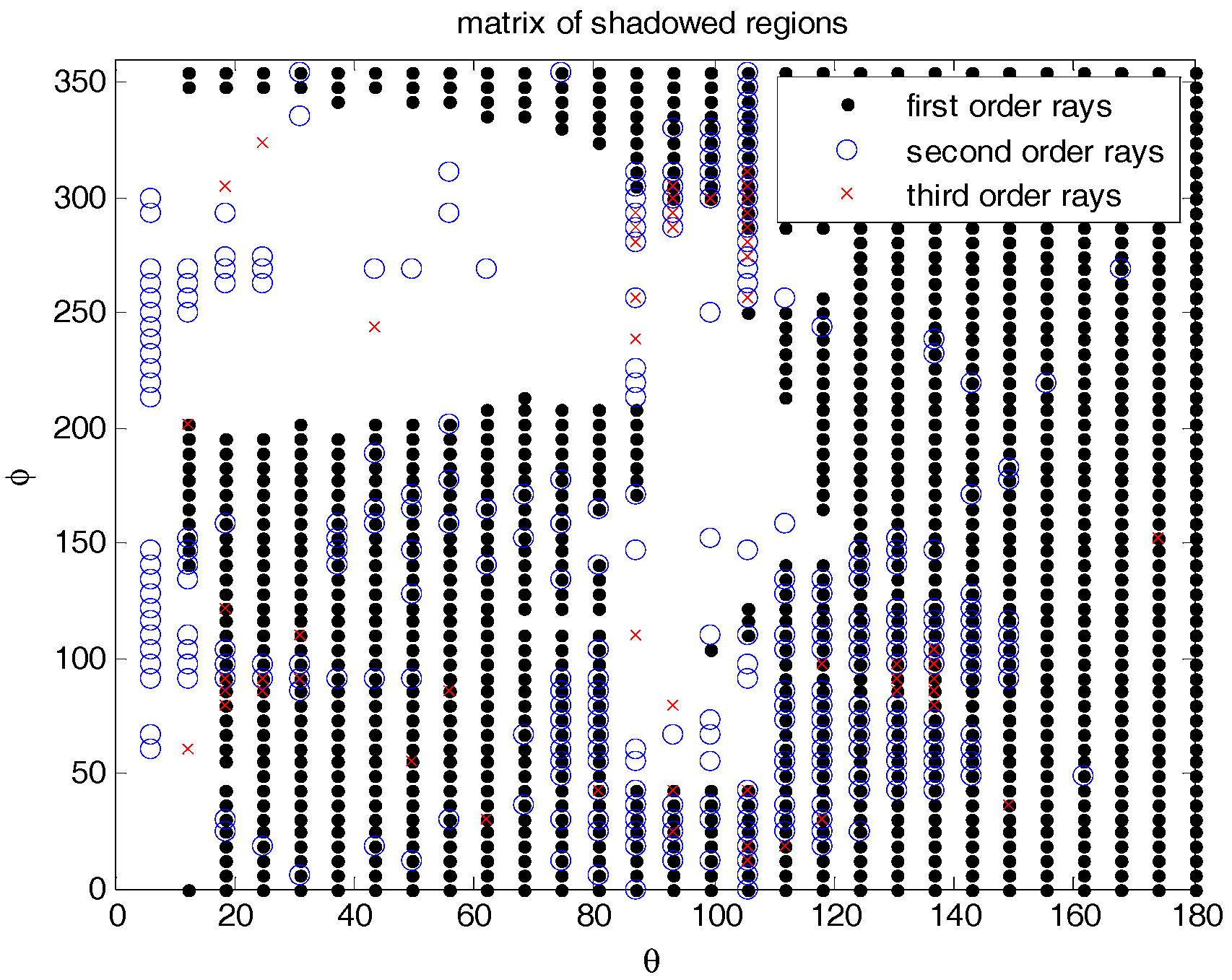

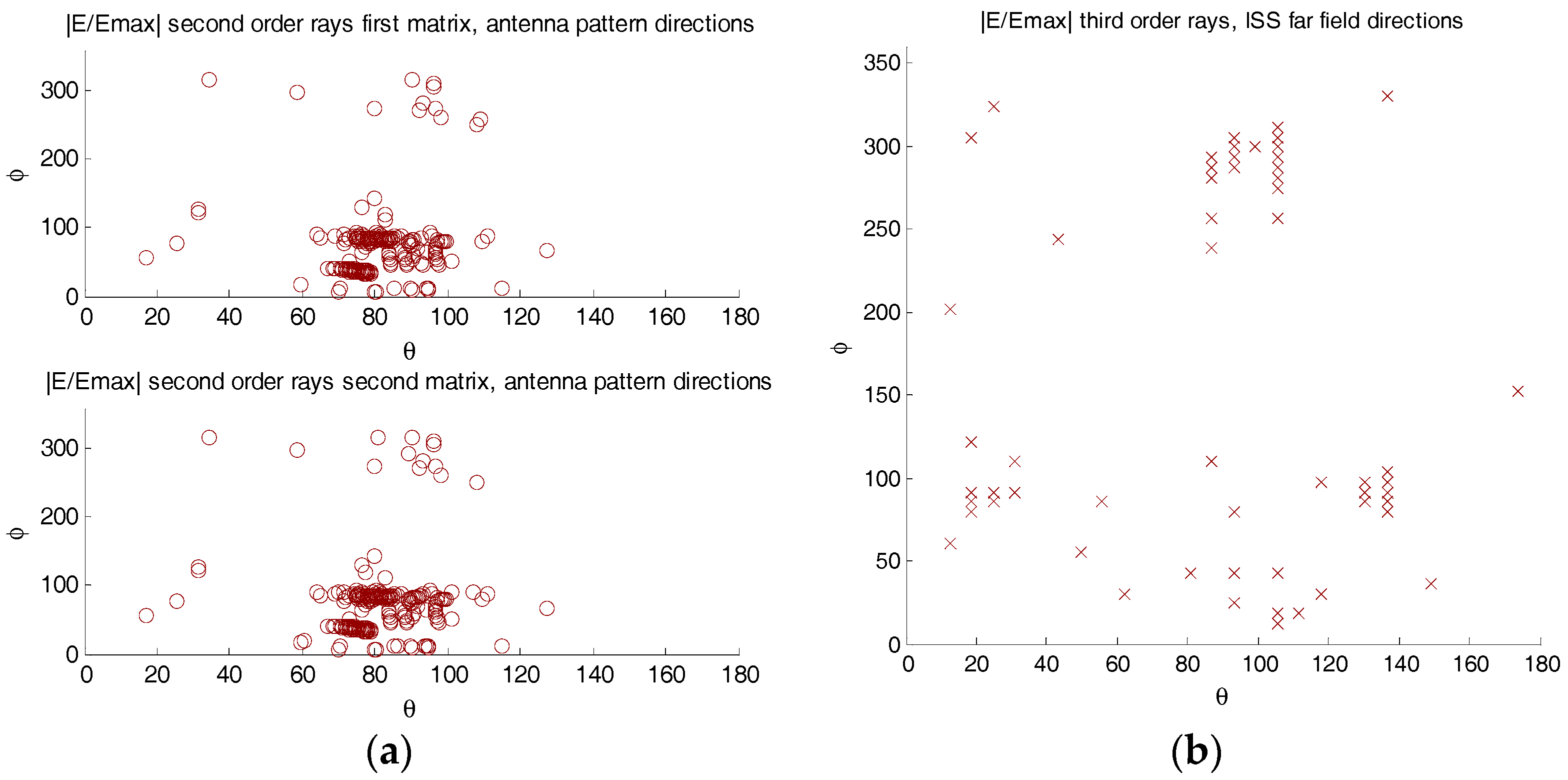
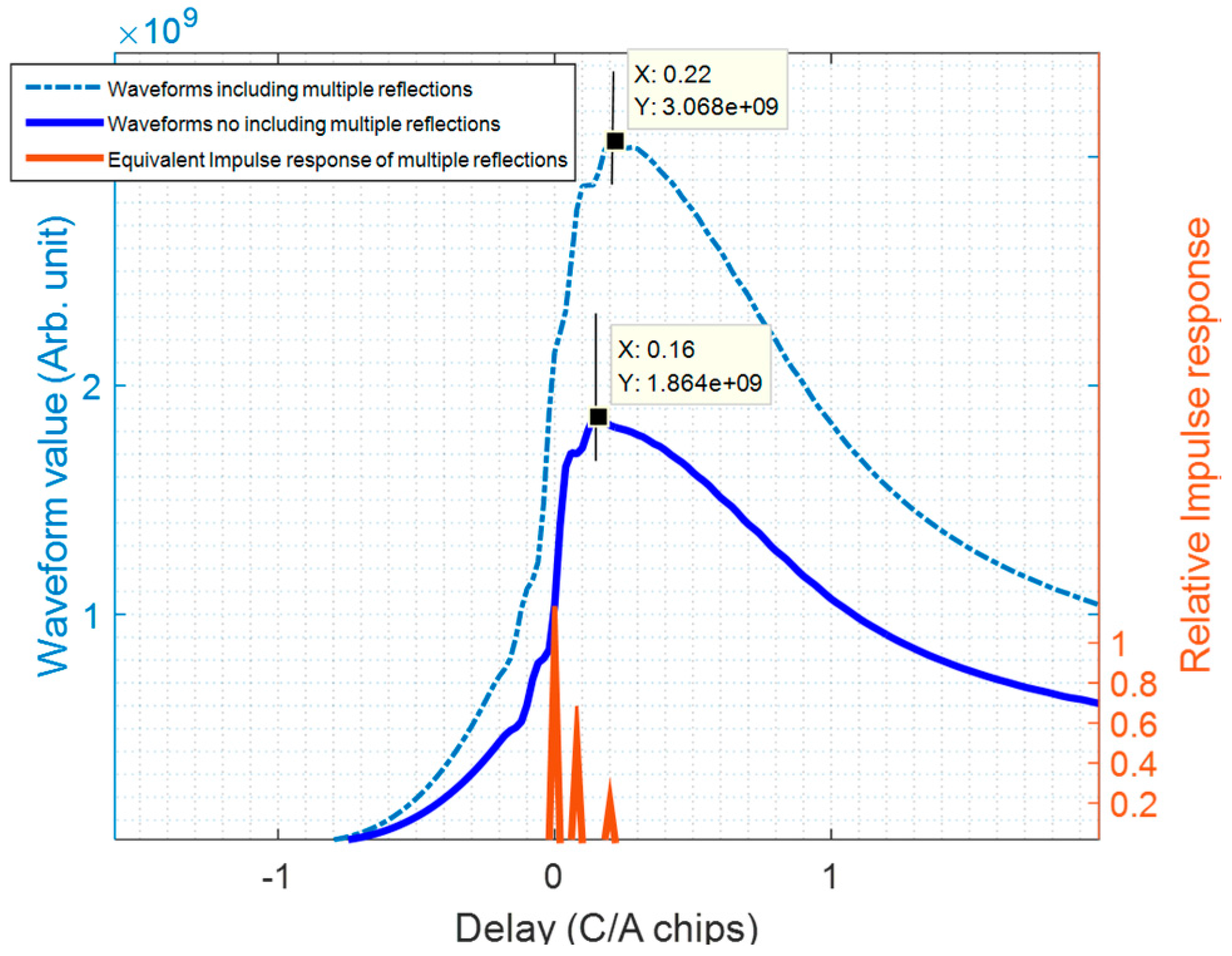
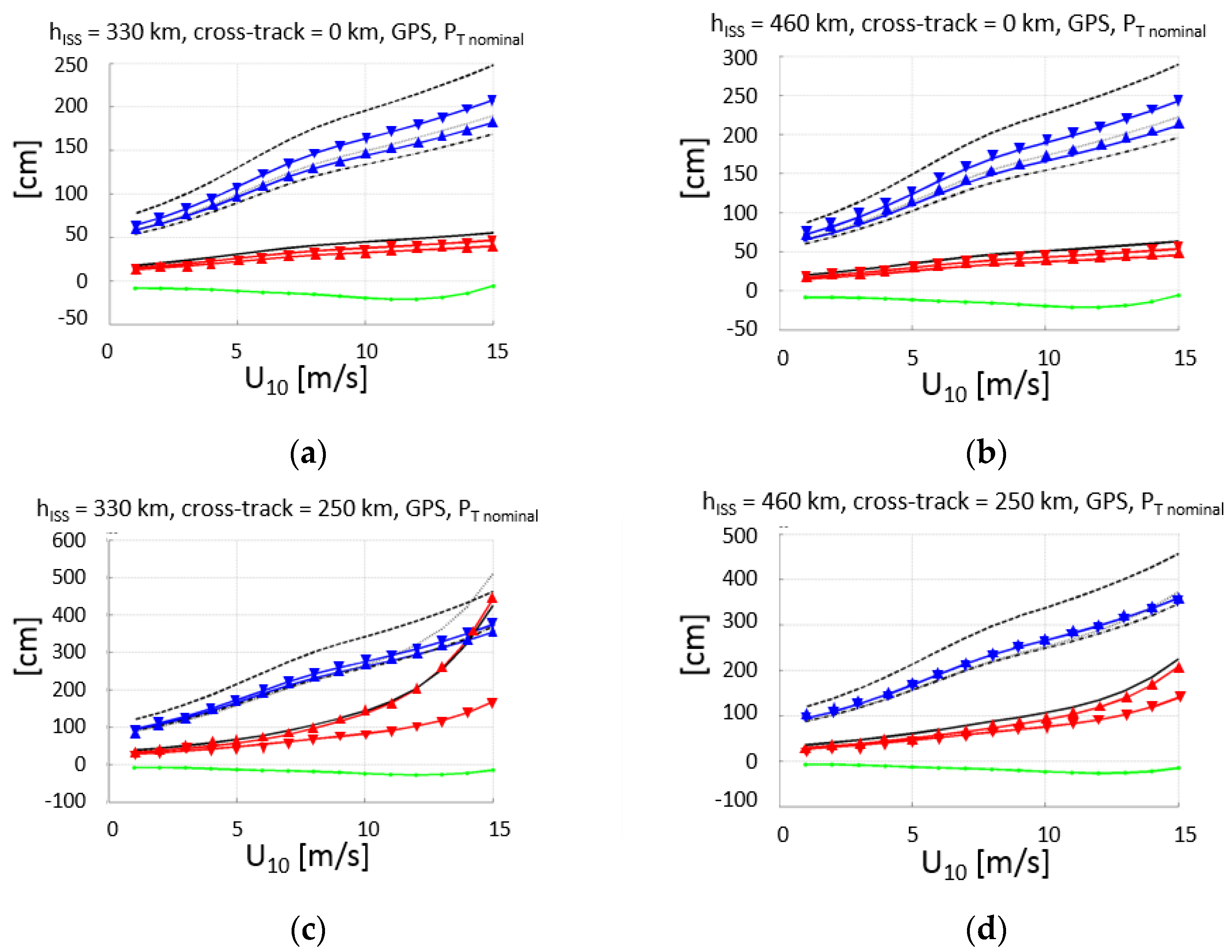
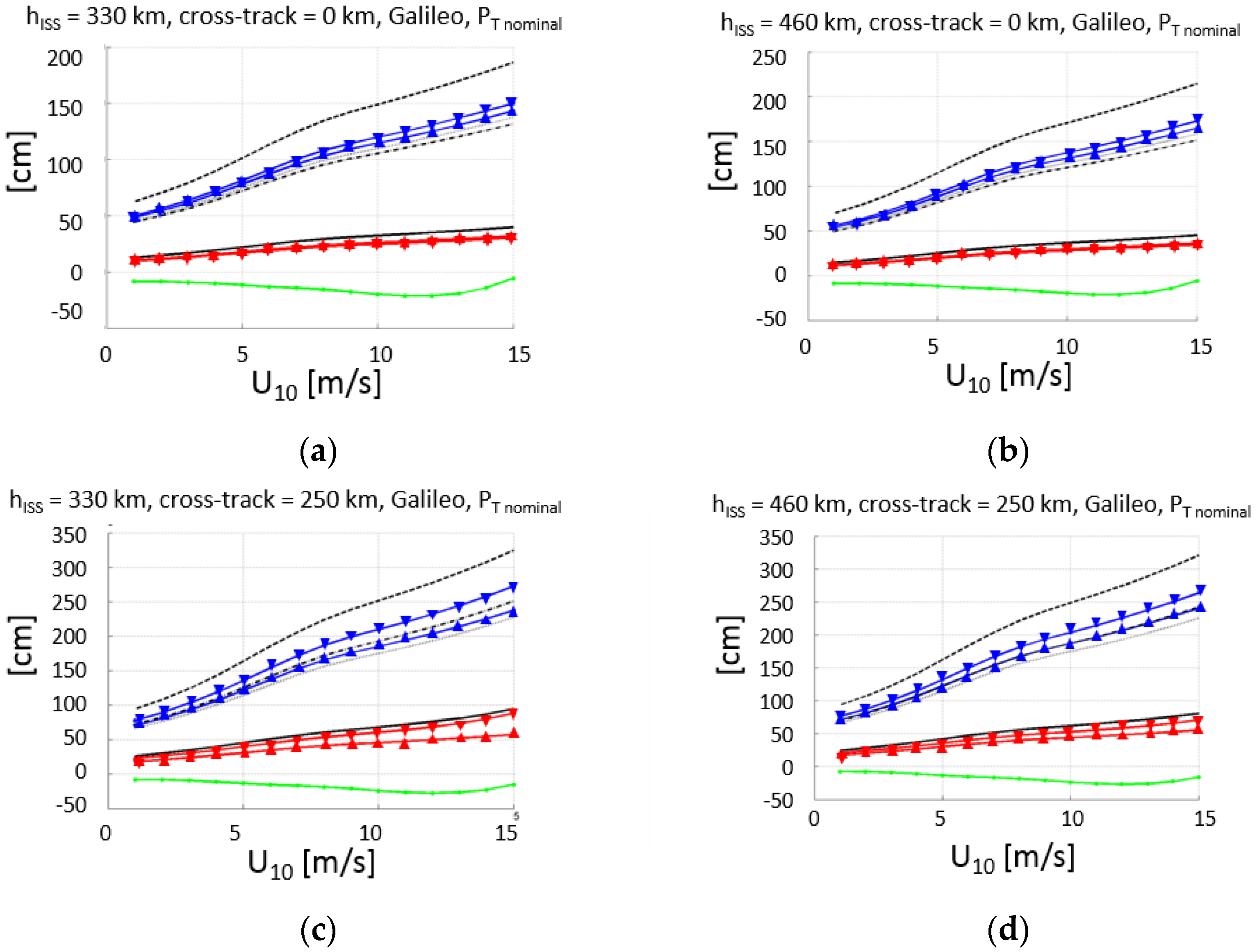

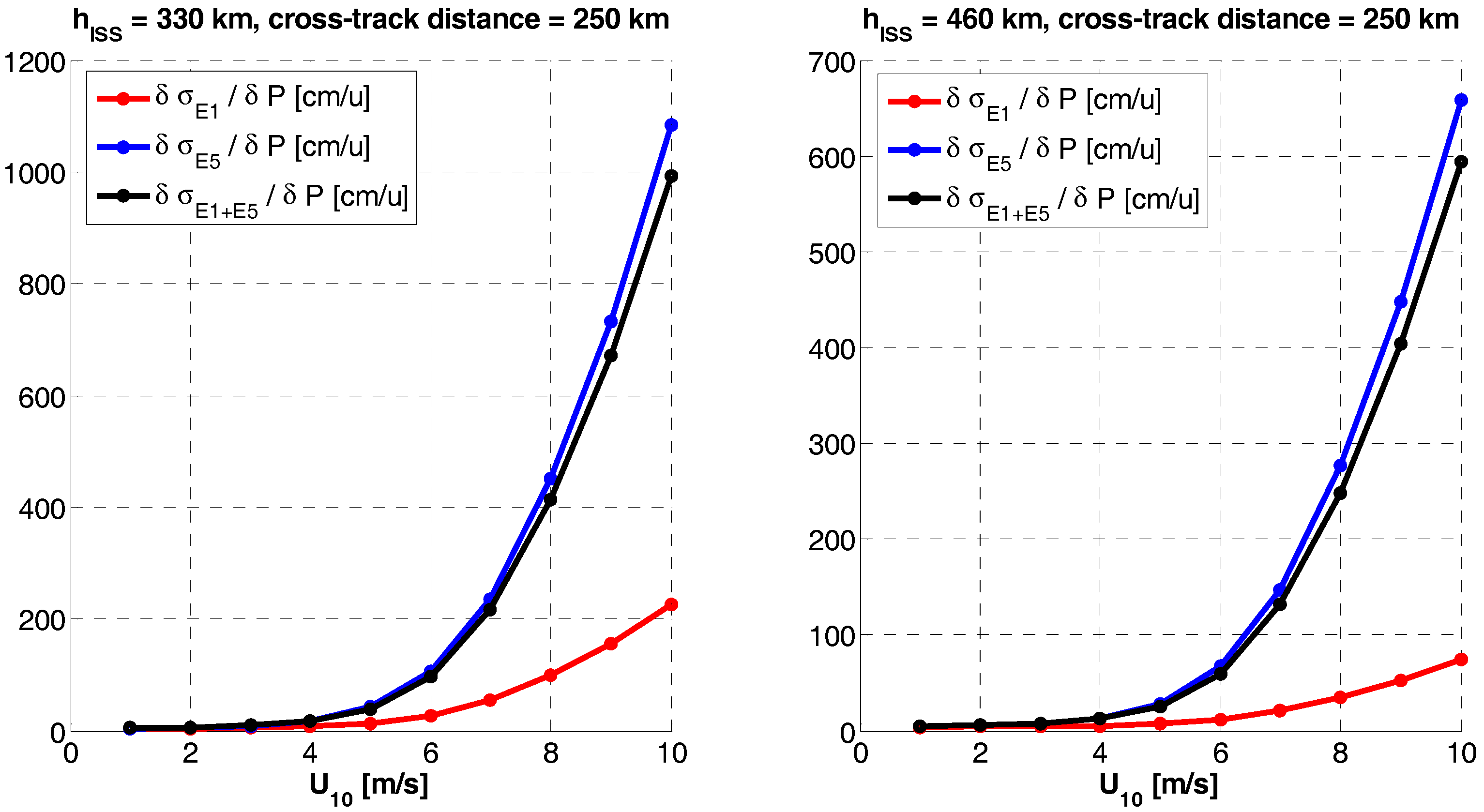
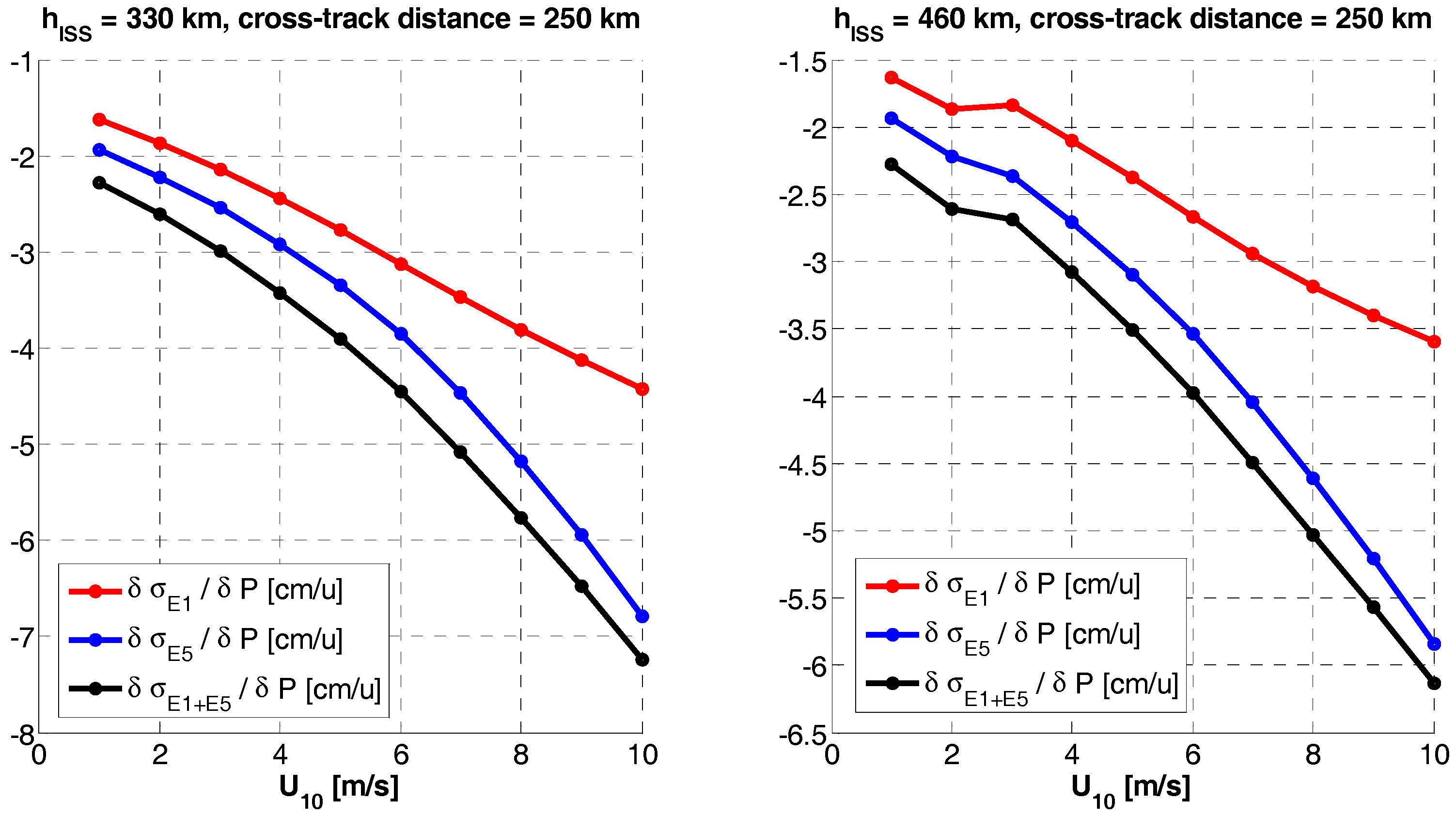
| Altimetry Precision [cmrms] | σh @ θi = 0° | σh @ θi = 35° | |||||
|---|---|---|---|---|---|---|---|
| Tcoh = 1 ms, Ni = 14,500 | Tcoh = 1 ms, Ni = 14,500 | ||||||
| PT,min | PT,typ | PT,max | PT,min | PT,typ | PT,max | ||
| Level-1 | L5 | 49.8 | 29.7 | 15.5 | 95.3 | 56.0 | 28.5 |
| Lower band (L5 + E5) | E5 | 10.1 | 8.3 | 7.2 | 19.1 | 15.5 | 13.3 |
| Level-1 | L1 | 22.5 | 16.4 | 12.9 | 51.2 | 37.2 | 27.6 |
| Higher band (L1 + E1) | E1 | 15.3 | 12.8 | 11.3 | 33.6 | 26.6 | 22.4 |
| Level-2 | L1&L5 | 49.2 | 30.5 | 18.1 | 97.4 | 60.5 | 35.7 |
| (LB + HB + iono correct.) | E1&E5 | 16.5 | 13.7 | 12.3 | 34.8 | 27.7 | 23.4 |
| U10 | θi,s = 0° | θi,s = 25° | θi,s = 45° |
|---|---|---|---|
| 5 m/s | −3.89 | −3.72 | −4.96 |
| 10 m/s | −8.37 | −9.73 | −13.8 |
| 15 m/s | −13.35 | −17.2 | −24.1 |
| Upper Band (L1/E1) | Lower Band (L5/E5) | |||
|---|---|---|---|---|
| Boresight | 35° | Boresight | 35° | |
| Dup-looking | 24.72 dB | 20.02 dB | 22.42 dB | 19.62 dB |
| Ddown-looking | 24.72 dB | 22.12 dB | 22.42 dB | 20.82 dB |
| hISS = 330 km | hISS = 460 km | ||||||||||
|---|---|---|---|---|---|---|---|---|---|---|---|
| GNSS | Cross Track | PT | U10 [m/s] | iF1-iF5 | cF1-cF5 | iF1-cF5 | cF1-iF5 | iF1-iF5 | cF1-cF5 | iF1-cF5 | cF1-iF5 |
| GPS | 0 km | min | 1 | 37 | 124 | 100 | 82 | 42 | 142 | 115 | 94 |
| 15 | 541 | 505 | 428 | 604 | 1502 | 649 | 566 | 1535 | |||
| nom | 1 | 18 | 77 | 58 | 53 | 20 | 87 | 66 | 60 | ||
| 15 | 55 | 248 | 190 | 168 | 63 | 289 | 222 | 196 | |||
| max | 1 | 10 | 53 | 37 | 39 | 11 | 58 | 41 | 44 | ||
| 15 | 31 | 148 | 102 | 112 | 35 | 170 | 117 | 129 | |||
| 250 km | min | 1 | 99 | 202 | 165 | 153 | 84 | 201 | 161 | 146 | |
| 15 | 410 | 1446 | 249 | 326 | 195 | 1442 | 64 | 184 | |||
| nom | 1 | 38 | 120 | 88 | 90 | 35 | 119 | 88 | 87 | ||
| 15 | 425 | 462 | 508 | 368 | 225 | 456 | 372 | 346 | |||
| max | 1 | 20 | 78 | 52 | 62 | 19 | 78 | 52 | 61 | ||
| 15 | 64 | 254 | 161 | 207 | 58 | 251 | 161 | 201 | |||
| Galileo | 0 km | min | 1 | 23 | 90 | 67 | 65 | 26 | 102 | 76 | 73 |
| 15 | 71 | 306 | 227 | 217 | 85 | 363 | 270 | 257 | |||
| nom | 1 | 13 | 62 | 46 | 44 | 14 | 69 | 51 | 49 | ||
| 15 | 40 | 186 | 137 | 132 | 45 | 215 | 158 | 152 | |||
| max | 1 | 6 | 41 | 30 | 29 | 7 | 45 | 33 | 32 | ||
| 15 | 20 | 103 | 76 | 73 | 23 | 117 | 86 | 83 | |||
| 250 km | min | 1 | 52 | 144 | 105 | 112 | 47 | 143 | 104 | 109 | |
| 15 | 7763 | 647 | 7747 | 810 | 2439 | 632 | 2432 | 658 | |||
| nom | 1 | 26 | 94 | 67 | 72 | 24 | 93 | 66 | 70 | ||
| 15 | 95 | 325 | 228 | 250 | 81 | 321 | 225 | 242 | |||
| max | 1 | 12 | 58 | 40 | 43 | 11 | 57 | 40 | 42 | ||
| 15 | 37 | 167 | 115 | 127 | 35 | 166 | 116 | 124 | |||
© 2017 by the authors. Licensee MDPI, Basel, Switzerland. This article is an open access article distributed under the terms and conditions of the Creative Commons Attribution (CC BY) license (http://creativecommons.org/licenses/by/4.0/).
Share and Cite
Camps, A.; Park, H.; Sekulic, I.; Rius, J.M. GNSS-R Altimetry Performance Analysis for the GEROS Experiment on Board the International Space Station. Sensors 2017, 17, 1583. https://doi.org/10.3390/s17071583
Camps A, Park H, Sekulic I, Rius JM. GNSS-R Altimetry Performance Analysis for the GEROS Experiment on Board the International Space Station. Sensors. 2017; 17(7):1583. https://doi.org/10.3390/s17071583
Chicago/Turabian StyleCamps, Adriano, Hyuk Park, Ivan Sekulic, and Juan Manuel Rius. 2017. "GNSS-R Altimetry Performance Analysis for the GEROS Experiment on Board the International Space Station" Sensors 17, no. 7: 1583. https://doi.org/10.3390/s17071583





